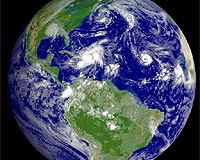| . |  |
. |
Baton Rouge LA (SPX) Jun 18, 2009 LSU's WAVCIS, or Wave-Current-Surge Information System for Coastal Louisiana, has a few new tricks up its sleeve in preparation for the 2009 hurricane season. Drawing from a pool of scientific talent at the university, across the nation and Europe, WAVCIS now offers graphic, easy-to-understand model outputs projecting wave height, current depths and tracks, salinity ratios and water temperature measurements that not only provide state-of-the-art guidance to emergency management officials, but also give federal and state agencies such as the United States Navy, National Oceanic and Atmospheric Administration, the National Weather Service, National Hurricane Center and Louisiana Department of National Resources new and improved ways to test their own modeling accuracy. "I believe WAVCIS is likely the most comprehensive program in the entire nation," said Gregory Stone, director of both the WAVCIS program and the Coastal Studies Institute and also the James P. Morgan Distinguished Professor at LSU. "We now have 60 to 84 hour advance forecasting capabilities due to our satellite link-ups with NOAA and our supercomputing capabilities. Because of these advancements, we are in much better shape for the 2009 hurricane season to provide valuable information than we were in the past." WAVCIS operates by deploying equipment in the depths of the Gulf of Mexico. Currently, they have sensors attached to numerous oil platforms. Instruments are attached to towers on the platforms and allow meteorological measurements - air temperature, wind speed and direction, visibility - to be made; state-of-the-art oceanographic sensors are placed underwater and on the sea floor. Advanced technology, including the Acoustic Doppler Profiler, an instrument that Stone's group has helped perfect in real time with the private sector, provides a very comprehensive overview of current velocities from the sea bed to the surface in addition to wave conditions on the sea surface. "In a normal weather situation, WAVCIS links with the satellites and retrieves up-to-date information every hour. This information is then immediately supplied to computer models at LSU's WAVCIS lab and the data are posted on the WAVCIS Web site," said Stone. "However, during a hurricane or other extreme weather events, we have the capacity to increase the frequency of these link-ups. We won't have the luxury of waiting an hour during the approach of a hurricane - it's critical that we can see what's going on out there in 15 to 30 minute intervals in order to accurately assess the situation." The WAVCIS group, a component of LSU's world famous Coastal Studies Institute, has sensors all throughout the Gulf of Mexico. In fact, most of the equipment used by WAVCIS is developed and maintained in-house at the Coastal Studies Institute's fabrication shop. Through a close and reciprocal relationship with NOAA's National Data Buoy Center, WAVCIS can also access that group's sensors, giving the system a gulf-wide look at emerging trends in waves and currents, which can be very important during the approach of a tropical cyclone. "Things such as the maximum wave height, wind speeds and storm surge, will play an integral role in issues concerning public safety," said Stone. "For example, the development of certain currents, such as the Loop current in the Gulf of Mexico, allows for almost immediate intensification of storms. That's why having an easy-to-understand and comprehensive end product was so important to my team and the Coastal Studies Institute, for example the Earth Scan Lab and the Southern Regional Climate Center, during the development stages. When it's crunch time and people are nervous, we want the facts to be clear." In addition to being a very active research group and providing graduate and undergraduate students with hands-on opportunities in an internationally-acclaimed lab, WAVCIS also provides other entities with the opportunity to test their own modeling accuracy. "By looking at the models they developed and then comparing them to ours and our measurements offshore, they can determine how accurate their models currently are and go about fine-tuning if necessary. This strengthens our knowledge of the oceanographic and coastal environment. Given the vulnerability of, for example coastal Louisiana and the oil and gas infrastructure in the Gulf of Mexico to erosion and hurricane impacts, it is important that the Federal Government, State of Louisiana and the oil and gas industry continue to support this effort," Stone said. Share This Article With Planet Earth
Related Links WAVCIS Louisiana State University Bringing Order To A World Of Disasters When the Earth Quakes A world of storm and tempest
 2009 Atlantic And East Pacific Ocean Hurricane Seasons Begin
2009 Atlantic And East Pacific Ocean Hurricane Seasons BeginCamp Springs MD (SPX) Jun 05, 2009 Summer soon begins in the Northern Hemisphere and, on June 1st, the Atlantic hurricane season kicks off. What do Atlantic and Pacific Ocean surface temperatures and heights tell forecasters about what they can expect this season? Although peak hurricane time doesn't arrive until late-summer and early fall, there are some oceanic signals that give a hint of coming activity and NASA satellites are ... read more |
|
| The content herein, unless otherwise known to be public domain, are Copyright 1995-2009 - SpaceDaily. AFP and UPI Wire Stories are copyright Agence France-Presse and United Press International. ESA Portal Reports are copyright European Space Agency. All NASA sourced material is public domain. Additional copyrights may apply in whole or part to other bona fide parties. Advertising does not imply endorsement,agreement or approval of any opinions, statements or information provided by SpaceDaily on any Web page published or hosted by SpaceDaily. Privacy Statement |